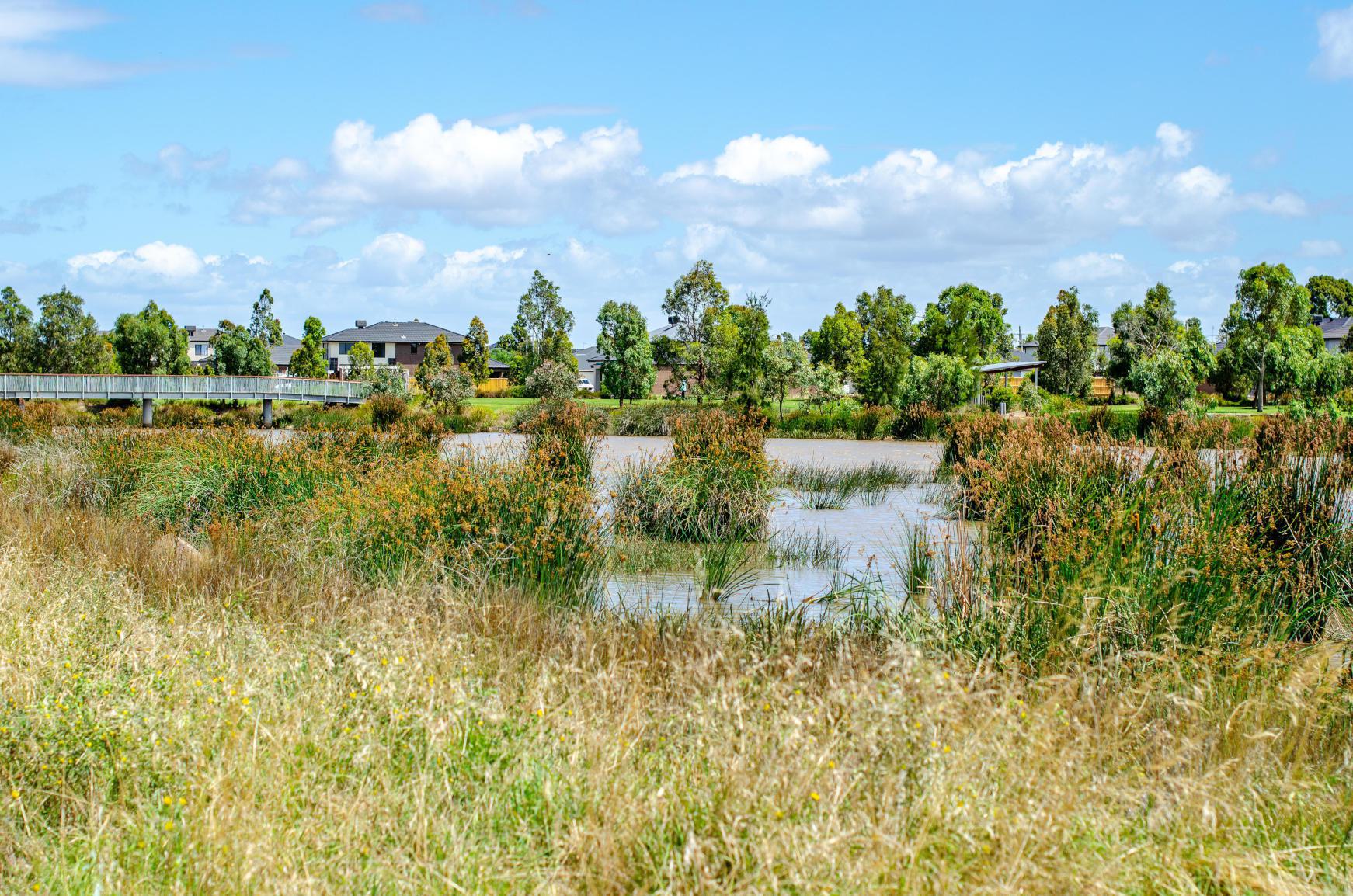Cattail Removal the Right Way: Why Dredging Offers the Longest-Lasting Solution
Cattails don’t simply arrive, they take over. What begins as a thin line along the shoreline quickly snowballs into dense stands that choke water flow, trap sediment, and disrupt routine pond maintenance. Left unchecked, a single plant can destabilize your entire system by producing seeds prolifically and spreading into dense colonies that block circulation and reduce depth faster than you expected-or budgeted for.
Here’s the core issue with most cattail control methods: they treat what you see and leave what drives regrowth. Cutting and mowing remove stalks but not roots; herbicides may knock back foliage yet leave rhizome networks intact, along with oxygen-robbing decay that stresses fish and water quality. The cycle repeats, more biomass, more muck, more cost. That’s not sustainable aquatic weed control; it’s a revolving door.
What you’ll learn below: how cattails become a system-wide problem, why traditional approaches stall out, and where dredging outperforms other options for aquatic weed control. We’ll cover practical decision points: timing, scope, and expected outcomes. This way you can choose a cattail control method that aligns with your goals, budget, and compliance needs.
(Spoiler alert) If you’re serious about restoring water quality, protecting equipment, and keeping your pond maintenance predictable, dredging offers a proven, long-view path to stability.
Understanding the Cattail Challenge in Your Pond or Lake

Cattails are aggressive colonizers that fundamentally alter your pond's ecosystem. Here's how a few scattered plants become a facility-wide crisis:
Rapid Spread and Dense Growth
A single cattail plant produces over 250,000 seeds annually, with underground rhizomes, which are the “root” of the problem.
Here’s why: Rhizomes are thick, horizontal underground stems that cattails use to spread and survive. Unlike roots, which mainly anchor plants and absorb water and nutrients, rhizomes serve as both a storage system and a means of expansion, spreading up to 10 feet per year.
They also contain 30–46% starch, making them critical for plant survival and rapid regrowth, according to the USDA. What starts as isolated growth along pond edges can quickly transform into dense stands that cover nearly 70% of a water surface in just two growing seasons.
Accelerated Sediment Accumulation
Dense cattail stands act like massive sediment traps, capturing organic matter and debris that would normally flow through your system. This doubles the rate of pond filling, turning a 20-year maintenance cycle into a 10-year emergency.
Compromised Water Flow and Quality:
Extensive cattail growth creates physical barriers that disrupt circulation patterns, leading to stagnant zones where dissolved oxygen levels plummet. Poor circulation means inefficient settling, reduced treatment capacity, and potential compliance issues with discharge standards.
Equipment Damage and Access Problems:
Thick cattail stands make routine maintenance nearly impossible, while root systems can damage pond liners and clog intake structures. Pump efficiency can drop by 30-40% when cattails restrict water flow to mechanical systems.
The Real Cost
Beyond the immediate operational impacts, cattail infestations can reduce your pond's effective capacity by an estimated 15-25% while dramatically increasing long-term maintenance costs. What should be routine pond management becomes complex aquatic weed control requiring specialized cattail removal techniques.
Don't wait for cattails to establish deep root systems and dense stands. Every growing season counts: the longer you postpone complete cattail removal, the more extensive and expensive the solution becomes.
Traditional Cattail Removal Methods and their Limitations
When cattails invade your pond or retention basin, the immediate instinct is to cut them down and call it solved. Here's the problem: traditional cattail removal methods are like putting a band-aid on a broken pipe. As you’ll see below, they address the visible symptoms while the real issue continues growing beneath the surface.
Manual Cutting and Mechanical Mowing
Most pond managers start with the obvious approach: cutting cattails at water level or using mechanical mowers. This method fails within 6-8 weeks because you're only removing the visible portion while leaving the extensive root system completely intact. Those roots can spread horizontally up to 10 feet and vertically down approximately 3-4 feet, immediately beginning to produce new shoots.
The cost? You'll spend up to 3-4 times annually on repeat treatments, with each cycle becoming more expensive as the root mass expands.
At AUS Dredge and Dive, we use a specialized weed harvester designed to cut and collect cattails efficiently. While this equipment does not remove the rhizomes, it clears dense stands quickly and provides essential access for dredging crews and equipment. By removing the surface biomass first, dredging can proceed more safely and effectively, ensuring that both the visible cattails and the root systems are fully eliminated.
Chemical Herbicide Applications
Aquatic herbicides promise longer-lasting results, and they do penetrate deeper than mechanical removal. However, herbicide treatments come with significant limitations:
A. Environmental restrictions often limit application timing and chemical types
B. Selective targeting is nearly impossible; beneficial aquatic plants suffer collateral damage
C. Decomposing cattail biomass depletes oxygen levels, potentially killing fish populations
D. Root systems remain in place, creating nutrient-rich sediment that encourages regrowth within 12-18 months
Root Barrier Installation
Some contractors suggest installing physical barriers around cattail colonies. While this prevents lateral spread, existing root systems continue thriving within the contained area. You've essentially created a permanent cattail garden that still requires ongoing management.
The Core Problem:
Every traditional method shares the same fatal flaw: they leave cattail root systems intact. These rhizome networks are the engine of cattail reproduction, capable of surviving harsh conditions and producing dozens of new shoots from a single root cluster.
When root systems remain, you're not managing cattails, you're scheduling your next treatment. The cycle repeats indefinitely, with costs compounding and effectiveness diminishing as colonies become more established.
Don't wait for traditional methods to fail again, there's a comprehensive solution that addresses the root cause, literally, which we’ll cover in the following section.
Dredging: The Superior Long-Term Solution for Cattail Control
When cattails overtake your pond, surface treatments and herbicides offer nothing more than temporary relief, the problem always returns, often worse than before. Dredging cattail removal addresses the root cause by eliminating the nutrient-rich sediment that feeds aggressive cattail growth year after year.
How Dredging Delivers Permanent Cattail Control
Dredging doesn't just remove cattails, it eliminates their ideal habitat. A systematic approach used by dredging companies like AUS Dredge and Dive targets the root of the problem:
A. Complete sediment removal: Extraction of the nutrient-rich muck where cattail root systems establish and spread.
B. Depth restoration: Increased water depth naturally discourages cattail establishment in treated areas
C. Nutrient cycle disruption: Removal of accumulated organic matter breaks the cycle that feeds persistent cattail growth
D. Bank stabilization: Strategic dredging prevents the shallow-water zones where cattails gain their strongest foothold
Pond Dredging Benefits Beyond Cattail Control
Properly executed dredging delivers multi-system improvements that compound over time. Water circulation improves dramatically when sediment barriers are removed. Oxygen levels stabilize as organic decomposition decreases. The entire aquatic ecosystem shifts toward conditions that naturally resist cattail dominance.
Long-term effectiveness studies consistently show that comprehensive dredging projects can maintain cattail control for 5-15 years (or even less frequently), depending on local sedimentation rates, making it a one-time or rare investment for long-term cattail control.
Compare this to 6-12 months for surface treatments that usually only last for a season. The initial investment in thorough sediment removal eliminates the recurring costs and labor associated with repeated maintenance treatments.
Timing Considerations for Maximum Effectiveness
Cattail root systems expand rapidly each growing season. Early intervention through dredging prevents the extensive rhizome networks that make future control increasingly difficult and expensive. Waiting for complete cattail takeover can substantially raise the scope, and cost, of effective restoration.
The optimal approach combines strategic dredging with proper timing to prevent re-establishment while restored water depths and circulation patterns naturally discourage future cattail growth.
Bottom line: When cattail control needs to last decades rather than months, comprehensive sediment removal through dredging offers a real proven solution that addresses root causes rather than symptoms.
Cost Analysis and ROI: Why Dredging Makes Financial Sense
So far, we’ve compared traditional cattail removal methods and dredging. When evaluating these options, it’s essential to weigh both upfront costs and long-term return on investment (ROI).
While surface-level cattail control methods, such as manual cutting or herbicide treatments, may appear cheaper initially, they typically offer only short-term relief, requiring repeat treatments as cattails regrow quickly. These recurring maintenance cycles drive up costs and can disrupt pond ecosystems.
But, dredging physically removes accumulated sediment and cattail rhizomes from the pond bottom, which targets the root cause of infestation. This thorough approach drastically slows cattail regrowth, extending the interval between interventions and reducing overall maintenance expenses.
When pond maintenance bills start piling up year after year, you're facing a choice: keep throwing money at temporary fixes, or invest in a solution that actually works long-term.
Comprehensive pond dredging is an important investment in the long-term health and beauty of your pond. The size of the pond and the extent of sediment buildup determine the best approach - whether mechanical or hydraulic dredging. By restoring depth and circulation now, you help prevent future maintenance headaches and protect the overall value of your property.
Mechanical dredging (excavator-based removal) typically runs on the lower end of that range for smaller residential ponds, especially when access is good and you're dealing with localized cattail root systems. You're looking at direct excavation and removal, which is-straightforward but limited by equipment access.
Hydraulic dredging usually commands higher costs but delivers more comprehensive sediment removal and better long-term cattail control. You're investing in a system that can reach areas mechanical equipment simply can't access.
The Lasting Results
It’s extremely critical to work with an experienced and ethical dredging company, because the wrong dredging method means you'll be back to square one in 2-3 years instead of 5-15.
After determining the correct dredging method for your cattail removal needs, you can expect the benefits of pond dredging to last 8-12 years before any maintenance is needed, as the process removes the nutrient-rich sediment that feeds cattail growth.
Remember, you’re not just paying for dredging, you're investing in 8-12 years of problem-free pond management. Compare that to annual or biannual treatments with other cattail control methods, and the math becomes clear: dredging delivers cost-effective, long-term results that temporary fixes simply can't match.
Take a California mining pond that was recently restored from cattail infestation as an example. The project successfully restored water clarity to a depth of 15 feet, with the deepest point reaching 18 feet. Most cattails were cleared, greatly improving operational efficiency by enhancing water flow and increasing storage capacity.
Take Action for Permanent Cattail Control
As we explored, when cattails choke your pond, every month you delay costs more than the month before. Root systems expand, sediment accumulates, and your water management efficiency plummets. Dredging cattail removal doesn't just clear vegetation, it eliminates the underlying conditions that allow cattails to dominate in the first place.
However, the benefits of dredging a pond extend far beyond cattail elimination: you're restoring proper water depth, removing decades of accumulated sediment, and preventing future vegetation takeover. This isn't just cattail management, it's complete pond restoration that tackles root causes, not just symptoms.
At AUS, our MSHA-certified team has delivered proven results across many ponds nationwide, combining specialized equipment with decades of aquatic vegetation control expertise. Your water systems are critical infrastructure, don't compromise their efficiency with band-aid solutions. Pond dredging eliminates cattail problems at the source while optimizing your entire water management system.





